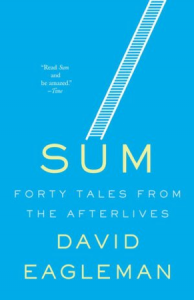In the vibrancy of our youth, how often do we stop to consider our deaths? Perhaps for the more morbidly minded among us, it’s fairly often. But nevertheless, the afterlife is a concept far temporally removed from we jolly youth. The question of what happens to us when we breathe our last is one of the fundamental human questions that we have sought to answer since the dawn of humanity. 
We get most of our theories about the afterlife from prophets or religious texts, philosophers or deities. Many of these have been around for millennia. According to Norse mythology, brave Scandinavians who die in battle are taken to Valhalla, presided over by the god Odin, where they eat, sleep, drink, carouse, and fight, much as they did in life. Classical monotheistic religions propose heaven and hell; some Eastern religions suggest reincarnation.
What if instead, we relive all our experiences, but with the events reshuffled, grouped together in clumps? We experience thirty years of sleep, six days clipping our nails, eighteen months waiting in line, fourteen minutes experiencing pure joy. Or perhaps in the afterlife, we work as background characters in other people’s dreams. Maybe God is in fact the size of a bacterium, and has no idea that we exist.
These proposed afterlives come from Sum, a collection of forty short stories of the afterlife, written by David Eagleman. Each of the forty tales is a different take on what happens when we die, and proffers a strange new way of understanding why we’re here.
Sum is an enlightening work of delicate genius. Eagleman’s influences come from religion, philosophy, anthropology, and his own field of neuroscience, combining to create little snapshots of unexpected humor, revelation, and introspection. His writing is crisp and tersely poetic, echoing long after the eyes have left the page. The vignette style, with stories lasting no more than four pages each, is perfect for quick but meaningful reading. One can pick it up anytime, on any page, and be guaranteed a brief, intense and thought-provoking sojourn into Eagleman’s vivid imagination. The one downside to this format is that it does not allow for long-term engagement with or development of each concept. But these little glimpses are ideal for college students with piles of academic literature to “read.” Take a break from the Tolstoy and take a moment to join Eagleman in his morbid musings.
Whatever our beliefs about the afterlife are, they don’t change the basic fact of our mortality. They do, however, have an enormous impact on the way we conduct ourselves over the span of our short lives. More than providing new theories for what happens after death, what Sum truly offers is a new perspective on life. After all, Eagleman acknowledges in each vignette that death must come to us all. What changes from one tale to another is the way that each afterlife determines the meaning of life itself. The post-mortem reality is a mirror that Eagleman holds up against the reality of the living. In the afterlife where events are reshuffled and clumped together, Eagleman allows us to reflect upon the daily flux and variety of life, and to appreciate the luxury of change. In the italicized excerpt above proposing three deaths, we are reminded of the perils of legacy, the capacity for truth to be obfuscated by the passage of time. In seeking to describe the afterlife, Eagleman negates it by showing that what matters is not what happens when we die, but rather what we choose to do while we are alive.

